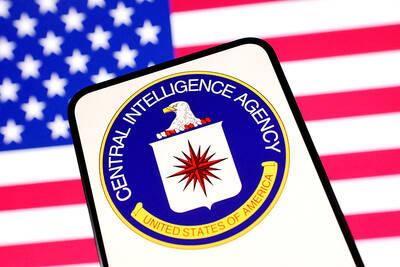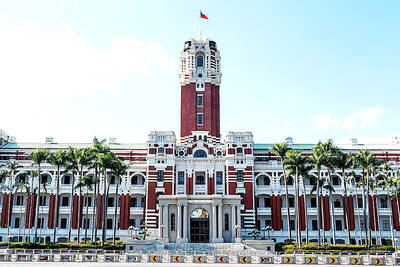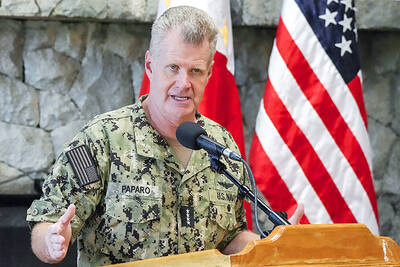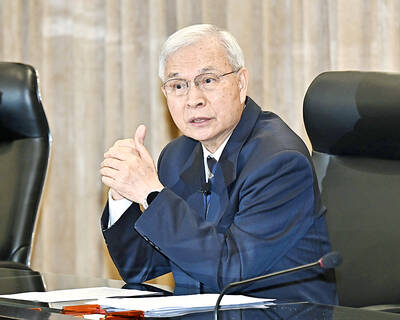Following years of inconclusive discussions, the heated debate on whether the National Palace Museum (故宮博物院) should set up a branch in southern Taiwan surfaced in the legislature again yesterday.
While proponents of the idea claim that the establishment of a branch in the south would help equalize the unbalanced cultural landscape in the northern and southern parts of of the country, those against the proposal remain skeptical.
They said the goal -- bridging the cultural rift between the two ends of the country -- would better be achieved by setting up museums on a smaller scale which would concentrate on displaying and preserving the local culture of those areas.
"The desire of people in the south -- to minimize the cultural gap between urban and rural districts -- is understandable. But I doubt the aim can be attained by setting up a branch of the National Palace Museum in the south," said DPP lawmaker Lin Cho-shui (林濁水).
"With a limited budget [earmarked for the promotion of cultural affairs], a better way of elevating the country's cultural standards is to clarify the purpose and role of existing museums, through which local culture and history can be better displayed, not to add more concrete buildings where nothing substantial is on display," Lin added.
Another DPP lawmaker, Chen Chin-jun (
"There are already 23 museums in the south of the country. The issue that the government needs to face is how to improve museums that already exist with the limited funding available, not to waste money on the construction of yet more museums," Chen said.
However, art scholars and lawmakers from the south viewed the issue differently.
DPP lawmaker William Lai (賴清德), independent lawmaker Josephine Chu (朱惠良), and Chang Yu-teng (張譽騰), an art professor at the Tainan National College of Arts, shared the notion that people from the south had long been treated unfairly by the government's biased policies on public buildings.
"Museum exhibits are national treasures, which should be admired equally by everybody," Chu said.
With regard to the complaint that people in the south are deprived of the convenience of visiting museums, Lin argued that the problem could be solved if the National Palace Museum was willing to lend its expositions to museums in the south.
The idea of setting up a branch of the museum in the south was first raised several years ago, when museum authorities said the 15,000 square meters facility in Taipei was insufficient for its 650,000 piece collection.
In contrast with the 70,000 square meters Metropolitan Museum of Art in New York, and the 60,000 square meters Musee du Louvre in Paris, the museum's deputy director, Shih Shou-chien (
Since Tu Cheng-sheng (杜正勝), the museum's director, took office last May, he has been lobbying the government to set up a branch in the south, primarily as a way of alleviating space constraints, and also to deflect criticism that the government has neglected the cultural needs of people in the south.

The CIA has a message for Chinese government officials worried about their place in Chinese President Xi Jinping’s (習近平) government: Come work with us. The agency released two Mandarin-language videos on social media on Thursday inviting disgruntled officials to contact the CIA. The recruitment videos posted on YouTube and X racked up more than 5 million views combined in their first day. The outreach comes as CIA Director John Ratcliffe has vowed to boost the agency’s use of intelligence from human sources and its focus on China, which has recently targeted US officials with its own espionage operations. The videos are “aimed at

STEADFAST FRIEND: The bills encourage increased Taiwan-US engagement and address China’s distortion of UN Resolution 2758 to isolate Taiwan internationally The Presidential Office yesterday thanked the US House of Representatives for unanimously passing two Taiwan-related bills highlighting its solid support for Taiwan’s democracy and global participation, and for deepening bilateral relations. One of the bills, the Taiwan Assurance Implementation Act, requires the US Department of State to periodically review its guidelines for engagement with Taiwan, and report to the US Congress on the guidelines and plans to lift self-imposed limitations on US-Taiwan engagement. The other bill is the Taiwan International Solidarity Act, which clarifies that UN Resolution 2758 does not address the issue of the representation of Taiwan or its people in

US Indo-Pacific Commander Admiral Samuel Paparo on Friday expressed concern over the rate at which China is diversifying its military exercises, the Financial Times (FT) reported on Saturday. “The rates of change on the depth and breadth of their exercises is the one non-linear effect that I’ve seen in the last year that wakes me up at night or keeps me up at night,” Paparo was quoted by FT as saying while attending the annual Sedona Forum at the McCain Institute in Arizona. Paparo also expressed concern over the speed with which China was expanding its military. While the US

SHIFT: Taiwan’s better-than-expected first-quarter GDP and signs of weakness in the US have driven global capital back to emerging markets, the central bank head said The central bank yesterday blamed market speculation for the steep rise in the local currency, and urged exporters and financial institutions to stay calm and stop panic sell-offs to avoid hurting their own profitability. The nation’s top monetary policymaker said that it would step in, if necessary, to maintain order and stability in the foreign exchange market. The remarks came as the NT dollar yesterday closed up NT$0.919 to NT$30.145 against the US dollar in Taipei trading, after rising as high as NT$29.59 in intraday trading. The local currency has surged 5.85 percent against the greenback over the past two sessions, central